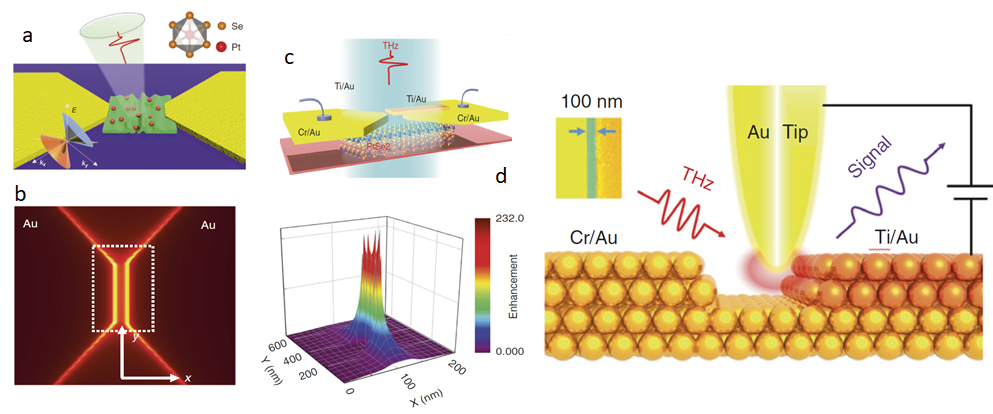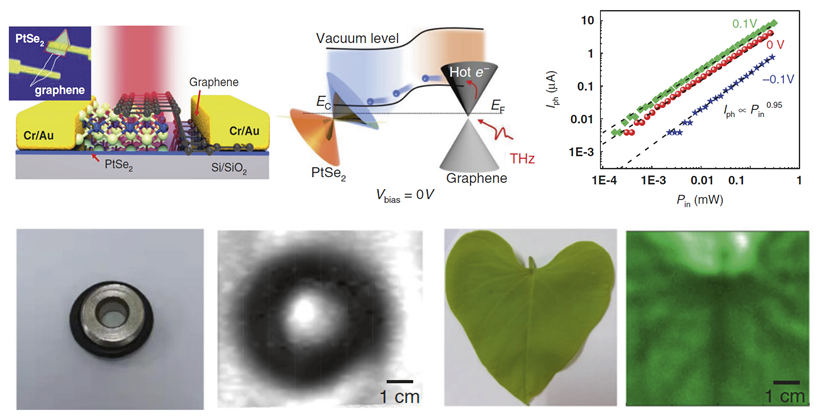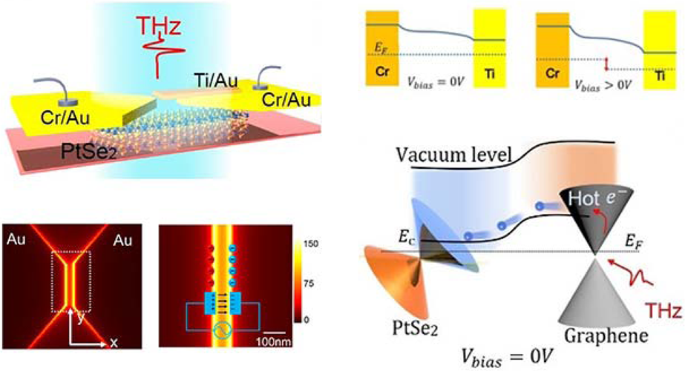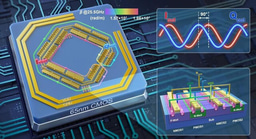Lightening up Topological-Semimetal Photoelectronics at Nanoscale beyond Interband-energy Limit
Published in Electrical & Electronic Engineering
Low-energy photodetection remains as a huge challenge in optoelectronic community for a long time due to the lack of suitable materials and optical principle that could efficient convert electromagnetic radiation into electrical signal with frequencies ranged from 0.1THz to 10THz[1][2]. Traditional photodetector relies on the separation of electron-hole pairs of gapped photo-excitation under the built-in field or reversed bias-voltage in PN or P-I-N structures in order for suppressing the dark current, and the detectable wavelength is determined the bandgap of materials which are working well at visible or near-infrared regime. While at longer wavelength, the difficulties in growth of high quality materials, large dark-current from the weak semiconductor-based junction, and thermal agitation noise, exacerbate the detectable photosignal at room-temperate [3]-[5]. The broad family of metallic TMDCs enables the emergence of type-II Dirac fermions in PtSe2-class system due to the versatile symmetry-breaking operation, leading to the unique platform of exotic physical properties and fascinating functionalities beyond early landmarks of traditional single-particle routes. The coexist of electron-hole pockets in PtSe2 system benefit the broad photon absorption capability down to the low-energy terahertz regime, with unprecedented opportunities to explore strong light-matter interaction in the deep subwavelength regime. The drawbacks and challenges of traditional photoelectric process not only lie in the efficient charge-separation mechanism, but also in the photon capturing due to the incommensurate between incident wavelength and active material.

Fig. 1. (a) Bow-tie shape of plasmonic antenna in coupled with PtSe2-class topological semimetal, (b) The profile of localized field in the subwavelength channel, (c) Asymmetrical nano-slit formation in the center of the channel, and (d) The near-field enhancement of spoof THz plasmon in the center of channel by more than three orders of magnitude.
The synergistic manipulation of optoelectronic capabilities for low-energy photon capturing and detection are engineering via ultrastrong interaction with near-field beyond skin-depth limit, van der Waals integration as well as in-plane symmetry-breaking. Here, the THz spoof-plasmon can be efficiently launched at metal-PtSe2 interface, by effectively focusing THz waves down into the nanoscale slit, i. e. l/30000 about five orders of magnitudes shorter than the wavelength. Even though the active area is very small, the near-field is enlarged by more than three orders of magnitude, giving rise to the ultrastrong interaction with type-II Dirac fermions and nonequilibrium hot-electrons production. THz-SNOM microscopy and theoretical calculation indicate the continuous grow-up of electromagnetic intensity at size much smaller than the skin-depth limit across broadband spectral regime

Fig. 2. van der Waals integration of hybrid Dirac-semimetal structure and interface hot-electron emission for elecromagnetic rectification with high dynamic regime and low-power fast-imaging ability.
Alongside the hot-electron production, the efficient rectification of chaotic hot-electrons is essential for low-energy photon harvesting at room temperature. Robust tilted evaporation method has been developed by shrinking the channel down to 20nm or beyond, and the material is asymmetrically contacted so that in-plane symmetry is broken. As a consequence, more than two-orders of performance can be improved benefiting from ultra-strong coupling and symmetry-breaking induced rectification, eliminates the drawbacks of dark-current and charge-separation issue for traditional narrow-gap optoelectronics and their limitation of room-temperature working. In addition, van der Waals integration via hybrid Dirac-semimetals can break out-of-plane symmetry further, showing integral optical-properties of segregated counterparts, and improved carrier transport, facilitating high signal-to-noise imaging capability, spontaneous photocurrent with NEP< 30pW/Hz0.5 as well as faster operation speed. Considering the superior ambient stability and the excellent potential of type-II Dirac semimetal, this work opens new possibilities for the facile realization of portable room-temperature, low-energy photon detectors, with high sensitivity, fast operation, and low NEP, and great advantages compared to current technologies. The results represent an important milestone on the roadmap towards the development of high-performance photonic devices, such as low-energy photon cameras, photodetectors, modulators etc. by exploring unique physical properties led by Dirac/Weyl fermiology.
Article Information
Hybrid Dirac semimetal-based photodetector with efficient low-energy photon harvesting, Light: Science&Applications, 11, 53(2022).
DOI: https://doi.org/10.1038/s41377-022-00741-8
Link: https://www.nature.com/articles/s41377-022-00741-8#citeas
References:
[1] Tonouchi, M. Cutting-edge terahertz technology, Nat. Photonics. 1, 97-105 (2007)
[2]Cocker, T. L.; Jelic, V.; Hillenbrand, R.; Hegmann, F. A. Nanoscale terahertz scanning probe microscopy. Nat. Photonics, 15, 558-569 (2021).
[3] Ma, Q. et al. Direct optical detection of Weyl fermion chirality in a topological semimetal. Nat. Phys. 13, 842-847 (2017).
[4] Rogalski, A. et al. Third-generation infrared photodetector arrays. J. Appl. Phys. 105, 091101 (2009).
[5] Bao, C. et al. Light-induced emergent phenomena in 2D materials and topological materials, Nat. Rev. Phys. 4, 33-48 (2022).
Follow the Topic
-
Light: Science & Applications

A peer-reviewed open access journal publishing highest-quality articles across the full spectrum of optics research. LSA promotes frontier research in all areas of optics and photonics, including basic, applied, scientific and engineering results.


Please sign in or register for FREE
If you are a registered user on Research Communities by Springer Nature, please sign in